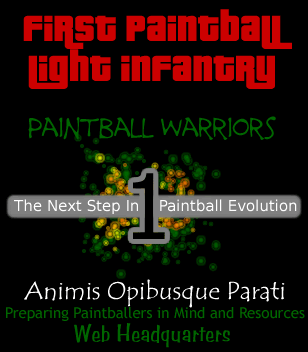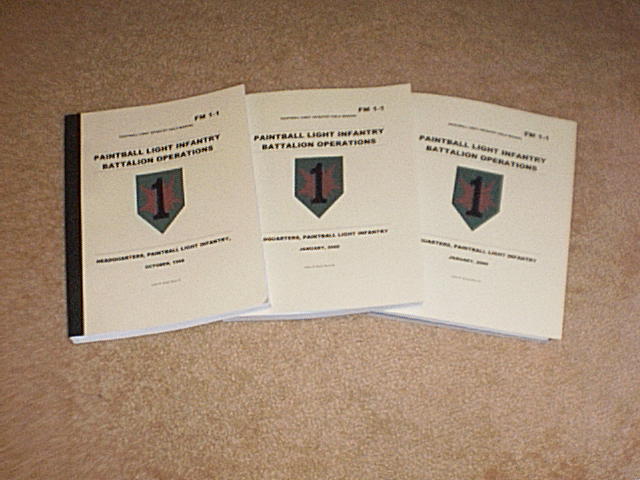PLI Field Manual 1-1
Paintball Light Infantry Operations Manual Abridged
Notice: This PLI manual is under revision. This is the effective version 3.5 (Abridged). New versions are forthcoming which are less "military" sounding and better reflect the PLI Philosophy. Many of these revision come after lengthy discussions with Scenario Industry Leaders like Pacman and Viper (of MXS Sports and Viper Scenario Games). The PLI is actively involved in big games, scenario games, and role playing games. New versions will include more references to this manner of play and better define our organization. The PLI is like the old IPPA...with tactics and organization. Many of the strict "Military" terms, ranks, formations, and descriptions in this manual would ONLY apply at strictly PLI Milsim events, but the ideas, procedures, and tactics will always work. For a better look at the PLI philosophy, read the PLI By Laws before reviewing this document. We are SIGNIFICANTLY more than a mere milsim group, so don't get bogged down in simple terminology! We truly are the next step in paintball evolution! The Mega-Team!
It should also be noted that while terms like squad, platoon, company, and ranks like sergeant, lieutenant, and captain are used, this is for simPLIcity and we are not "locked" into a military rank system. Nearly everyone understands what a squad or sergeant is, and that is why we will keep these designations in the manual; However, in the field, if we are portraying the Mafia, the designations would be appropriate (Godfather, Consigliere, Capo, Wiseguy, soldier, Etc.). If portraying the FBI (IA, Special Agent, Supervisory Special Agent, Special Agent in Charge, Assistant Special Agent in Charge, Assistant Director, Director, etc). If portraying a mob of hungry orcs, then we will be whatever that is called. If protraying a platoon of soldiers, then that is what we will be. Bear in mind that the PLI will not always be in command and will fall into whatever structure is being used by the event host. You are a playing the role of a soldier,elf,orc,robot,SA,wiseguy,or whatever and NOT a "pli Sergeant" playing the role of one.
PLI members are NEVER assigned a rank within the Organization except by the By Law titles "Executive Coordinator", "BC Council Representative", "Detachment Liaison", or "Member". There is NO such thing as a Colonel of the PLI, rather at an event a member would be PORTRAYING a colonel JUST FOR THE EVENT. The Battalion level organization depicted here in FM 1-1 would be used at a military style event where the PLI was acting AS a battalion and looks to the future when there is more than just the 1st PLI, but numerous mega teams capable of fielding large organized units.
The tactics of the squad, platoon, and company will work no matter what the unit is called, BUT SHOULD ALWAYS BE INCORPORATED INTO THE STORY LINE OF THE EVENT, NOT FORCED INTO IT. Military terms are used to simPLIfy understanding and enhance the PLI, not lock it into a Military Structure.
FM 1-1 Table of Contents
Version 3.5 (05-01-2000)
Under Revision
Preface
Introduction
CHAPTER 1. Protocols, Doctrine, and Philosophy
Philosophy
Mission
Goals
The Paintball Warrior
Code of Conduct
Zero Tolerance Policy
Responsible Use of Full Auto
The PLI Protocols
CHAPTER 2. PLI Organization
Table of Organization and Equipment
Duties and Responsibilities
Inspection
Camp
Field Leadership (Under extensive revision) (this is NOT the revised version)
Organizational Leadership
CHAPTER 3. Equipment
Individual Equipment List
Organizational Dress
Footwear
Goggles
Harness
Talkabout Radio
Scopes and Binoculars
Night Vision
Global Positioning System
Special Operational Gear
CHAPTER 4. Weapons
Primary Marker
Secondary Marker
Squad Automatic FA Marker
Paintball Assault Launcher
Paint Grenades
Special Weapons
Paintball Marker Reference Guide
CHAPTER 5. Combat Preparation
Planning
Definitions
Leadership
Responsibilities of a Leader
Scenario Game Success
Marksmanship
Paintball Personality Types
Training
Scenario Game Equipment List
CHAPTER 6. Individual Tactics
Basics
Infantryman
Squad Automatic Weapo Gunner
Paintball Assault Weapon Grenadier
Mortarman
Sniper
Movement
CHAPTER 7. 5 Man Squad Tactics
Overview
India
Echo
Tango
Yankee
Delta
Victor
Whiskey
Alpha
Bravo
Charlie
Foxtrot
Charlie Foxtrot
Other
CHAPTER 8. Platoon Tactics
Coordination
Movement
Command and Control of the PLI Platoon
Platoon Tactics
Platoon Echo
Platoon India
Platoon Whiskey
Platoon Delta
Platoon Foxtrot
Platoon Bravo
Platoon Victor
Platoon Charlie
Chapter 9. Squad/Platoon Immediate Action/SOP's
Immediate Action Drills
Combat Drills
Clock System
Night Vision Figure Eight Method
Rally Point
Firing Positions
Indirect Fire
Freeze
Hasty Ambush
Immediate Assault
Squad Combat Drill
Platoon Combat Drill
React to Enemy Ambush
Knock Out Bunkers
Clear a Building/Room
Enter/Clear an Enemy Trench
Break Contact
CHAPTER 10. School of the Company
Preparing For War
The Soldier
The Leader
The Unit
Training the Company Commander
Combat Power
Tenets of the Paintball Warrior Battle Doctrine
Paintball Warrior Battle Imperatives
Battlefield Operating Systems
Command and Control
Organization of PLI Company
Table of Organization
CHAPTER 11. Company Tactics
Movement
Locations of Key Leaders
Movement Formations
Legend of Symbols
Column
Line
Wedge
Vee
File
Echelon(R/L)
Formation Selection
Movement Techniques
Traveling
Traveling Overwatch
Bounding Overwatch
Control Techniques
Security During Movement
Company Defense Perimeter
Basic Offensive Tactics
Basic Defensive Tactics
CHAPTER 12.The School of the Battalion
Command of the Paintball Battalion
The Role of the Paintball Light Infantry Battalion
Paintball Warrior Battle Doctrine
Fundamentals of Paintball Warrior Battle
Combat Power
Mission
Operating Systems
Command and Control
Battalion Command Positions and Responsibilities
CHAPTER 13.Special Operations
Tactical use of Smoke
Position Assault
Ambush
Position Defense
Night Operations
Infiltration
Urban Assault
Jungle Operations
Desert Operations
Reconnaissance
CHAPTER 14.Fundamentals of Camouflage
Avoiding Detection
Identify the Threat
Avoiding Routine Surveillance
Countermeasures
Employing Realistic Camouflage
Near IR Sensors
IR Sensors
UV Sensors
Acoustic Sensors
Radio Sensors
Minimize Movement
Using Decoys
Recognition Factors
Avoid Patterns
Reflectance
Shape
Shadow
Movement
Noise
Texture
Patterns
Site Selection
Mission Assessment
Site Selection
Dispertion
Terrain Patterns
CCD DisciPLIne
CHAPTER 15.Camouflage Techniques/Materials
Techniques
Tests and Evaluations
Natural Conditions
Materials
Decoys
CHAPTER 16. Individual Camouflage
Materials
Considerations
DisciPLIne
Dispersal
Employment
Skin
Uniforms
Equipment
Individual Fighting Positions
CHAPTER 17. Special Camouflage Environments
Deserts
Snow Covered Terrain
Urban Environment
CHAPTER 18. Special Forces
Special Forces
Snipers
Engineers
Fast Reconnaissance Team
Saboteurs
Spies
Mechanized Infantry
Armor
Headquarters Security Element/Company
Mortars
Grenadier Squad/Platoon
CHAPTER 19. Communications
Tactical Radio Use
Ten Codes
Command Net Radio Frequencies
Silent Communications (ASL)
CHAPTER 20. Safety Rules and Regulations
Overview and Credit
Goggle Safety and Maintenance
Barrel Plug Safety and Maintenance
Paintmarker Safety
Chronographing
CO2, HPA, and 12 Gram Safety
Alternate Safety Gear
CHAPTER 21. Equipment Care and Maintenance
Proper Care and Storage of Paintballs
Weapons Maintenance
Uniform Cleaning
|
|

